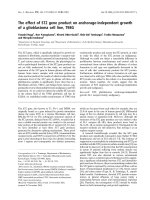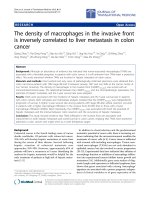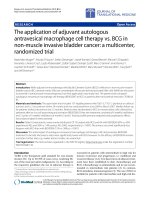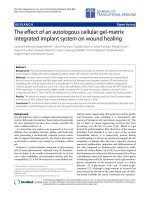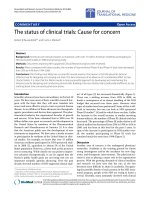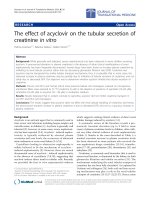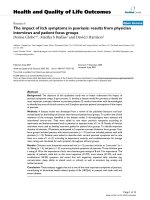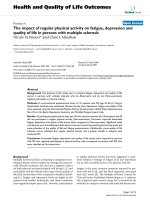báo cáo hóa học:" The effect of newer anti-rheumatic drugs on osteogenic cell proliferation: an in-vitro study" doc
Bạn đang xem bản rút gọn của tài liệu. Xem và tải ngay bản đầy đủ của tài liệu tại đây (327.16 KB, 7 trang )
BioMed Central
Page 1 of 7
(page number not for citation purposes)
Journal of Orthopaedic Surgery and
Research
Open Access
Research article
The effect of newer anti-rheumatic drugs on osteogenic cell
proliferation: an in-vitro study
Ajay Malviya*
1
, Jan Herman Kuiper
2
, Nilesh Makwana
3
, Patrick Laing
3
and
Brian Ashton
4
Address:
1
Wansbeck General Hospital, Woodhorne Lane, Ashington, Northumberland, NE63 9JJ, UK,
2
Joint Reconstruction Unit, Robert Jones
and Agnes Hunt Orthopaedic Hospital, Oswestry, SY10 7AG, UK,
3
Orthopaedic Department, Robert Jones and Agnes Hunt Orthopaedic Hospital,
Oswestry, SY10 7AG, UK and
4
Arthritis Research Centre, Robert Jones and Agnes Hunt Orthopaedic Hospital, Oswestry, SY10 7AG, UK
Email: Ajay Malviya* - ; Jan Herman Kuiper - ; Nilesh Makwana - NILESH.MAKWANA@new-
tr.wales.nhs.uk; Patrick Laing - ; Brian Ashton -
* Corresponding author
Abstract
Background: Disease modifying anti-rheumatic drugs (DMARDs) may interfere with bone
healing. Previous studies give conflicting advice regarding discontinuation of these drugs in the peri-
operative setting. No consensus exists in current practice especially with the newer DMARDs such
as Leflunomide, Etanercept, and Infliximab. The aim of this study was to assess the in-vitro effect
of these drugs alone and in relevant clinical combinations on Osteoblast activity.
Methods: Osteoblasts were cultured from femoral heads obtained from five young otherwise
healthy patients undergoing total hip replacement. The cells were cultured using techniques that
have been previously described. A full factorial design was used to set up the experiment on
samples obtained from the five donors. Normal therapeutic concentrations of the various
DMARDs were added alone and in combination to the media. The cell proliferation was estimated
after two weeks using spectrophotometric technique using Roche Cell proliferation Kit. Multilevel
regression analysis was used to estimate which drugs or combination of drugs significantly affected
cell proliferation.
Results: Infliximab and Leflunomide had an overall significant inhibitory effect (p < 0.05).
Dexamethasone had a small stimulatory effect that was however strongly donor-dependent. The
cox-2 inhibitor Etoricoxib was found to negate or increase the action of two other drugs
(Leflunomide and Dexamethasone). Methotrexate and Etanercept had no discernable donor-
dependant or donor-independent effect on osteoblast proliferation.
Conclusion: Our study indicates that in-vitro osteoblast proliferation can be inhibited by the
presence of certain DMARDs. Combinations of drugs had an influence and could negate the action
of a drug on osteoblast proliferation. The response to drugs may be donor-dependent.
Published: 26 May 2009
Journal of Orthopaedic Surgery and Research 2009, 4:17 doi:10.1186/1749-799X-4-17
Received: 9 May 2008
Accepted: 26 May 2009
This article is available from: />© 2009 Malviya et al; licensee BioMed Central Ltd.
This is an Open Access article distributed under the terms of the Creative Commons Attribution License ( />),
which permits unrestricted use, distribution, and reproduction in any medium, provided the original work is properly cited.
Journal of Orthopaedic Surgery and Research 2009, 4:17 />Page 2 of 7
(page number not for citation purposes)
Introduction
Patients with various rheumatologic and inflammatory
disease states commonly require drugs for adequate con-
trol of their condition. It is well recognized that certain
anti-rheumatic drugs may affect inflammation and local
immune responses, which are necessary for proper wound
healing in the peri-operative setting, thereby potentially
resulting in undesirable postoperative complications[1].
Normal bone healing is an essential requisite in the
appropriate management of patients with inflammatory
arthritis who have fractures or have undergone fusion pro-
cedures. It has been anecdotal that, despite good surgery,
the results are not always satisfactory. This is possibly due
to altered bone healing as a result of the disease process
and/or the drugs being used for treatment. It has been
argued that these effects might be patient-specific[2].
There is of course the risk of inflammatory flare up on
withholding these drugs and this may itself increase the
risk of complications[3]. Clinicians must, therefore, care-
fully evaluate individual patient risk factors, disease sever-
ity and the pharmacokinetics of available therapies when
weighing the risks and benefits of discontinuing therapy
in the peri-operative setting[1].
Several studies, mostly in vitro studies or animal experi-
ments, have been carried out to study the effects of Dis-
ease Modifying Anti-Rheumatic Drugs (DMARDs) on
bone healing [4-7]. These studies have demonstrated an
inhibition of osteoblast proliferation in-vitro in the pres-
ence of Methotrexate with no significant effect on osteob-
last differentiation. The effect has been shown to be dose
dependent [4-7] with some proposing that, at therapeutic
dose used in treatment of rheumatoid arthritis, there is no
significant effect[6].
Nonsteroidal anti-inflammatory drugs (NSAIDS) are also
used in the treatment of rheumatoid arthritis, alone or in
combination with DMARDs. It has been shown these
adversely effect bone healing [8-13] and this may be more
profound during early stages of fracture repair[14]. How-
ever, it has been thought that short term use of NSAIDS
inhibitors would not produce any deleterious effect
because their effect is reversible and dose depend-
ent[12,15,16]. It is acknowledged that these drugs should
be used with caution in all patients following osseous
trauma, particularly after injuries that may predispose a
fracture to delayed union due to osseous, vascular or
patient-related factors[11].
There is very little knowledge regarding the effect on bone
healing of the newer anti-rheumatic drugs such as Leflu-
nomide and anti-TNF drugs like Etanercept and Inflixi-
mab. It is well recognised that patients with severe disease
that requires surgery normally receive a combination of
drugs. The effect of these drugs in combination has again
not been looked into. The need for more data on the peri-
operative use of DMARDs and biological agents to formu-
late appropriate guidelines has been established in some
reviews[17,18].
In light of these many uncertainties, we carried out an in-
vitro study of the effect of various antirheumatoid drugs
alone and in combination on the proliferation of osteo-
genic cells derived from the trabecular bone of resected
femoral heads. Uniquely, we looked into the effect of
Leflunomide, Etanercept and Infliximab and also various
clinically relevant combinations of these drugs. Specifi-
cally, we tested the following three hypotheses: (I) these
drugs affect osteogenic cell proliferation, (II) their effects
on cell proliferation are patient-specific, and (III) these
drugs enhance or reduce each other's effects when com-
bined.
Methods
General study design
A full factorial design of Experiments approach was used
to generate a scheme of drug combinations added to the
medium in which trabecular bone fragments from 5 indi-
vidual donors were grown. The number of osteogenic cells
generated during a 14 day culture period was the outcome
variable.
Drugs
The effects of six different drugs were investigated (Table 1).
The six drugs were divided in three groups, based on the clin-
ical likelihood of being used in combination. A drug from
any group could be combined with a drug from another
Table 1: The six drugs tested.
Drug Concentration (μg/ml or nM)
Group 1 COX-2 inhibitor – Etoricoxib 4 μg/ml (1.1·10
-5
M)
Group 2 Methotrexate 1 μg/ml (2.2·10
-6
M)
Group 3 Dexamethasone 4 ng/ml
Etanercept (anti-TNF; rh soluble TNF-receptor) 1 μg/ml
Infliximab (anti-TNF; chimeric monoclonal antibody) 118 μg/ml
Leflunomide (pyrimidine synthesis inhibitor) 4 μg/ml (1.5·10
-5
M)
The drugs were combined between groups, but not within groups
Journal of Orthopaedic Surgery and Research 2009, 4:17 />Page 3 of 7
(page number not for citation purposes)
group, but not with a drug from the same group. In other
words, the four drugs from group 3 were not combined.
Samples of pure drugs were obtained directly from the
manufacturers and stable solutions were prepared accord-
ing to the manufacturers instructions. Therapeutic con-
centrations of the drugs were added to tissue culture
medium from Day 1 in various combinations.
Trabecular bone samples
With approval of the Local Research Ethics Committee,
trabecular bone specimens were collected from femoral
heads of five relatively young (50–60 yrs) consented
donors undergoing total hip replacement for indications
other than inflammatory arthritis and who had not been
prescribed any of the drugs under study.
Culture Methods
Osteoblast-like cells were isolated and cultured from
trabecular bone of femoral head, as has been described
previously [19-21]. Briefly, the trabecular bone was blot-
ted dry and pulled into fragments 2–3 mm in each dimen-
sion using forceps. These were washed with several
changes of tissue culture medium (α-MEM with Earle's
salt and L-Glutamine – Gibco, Paisley, Scotland) to
remove cells remaining in the intra-trabecular spaces and
plated at 1 fragment per well in a 24-well plate containing
1 ml of control medium (α-MEM containing 1% Gen-
tamicin v/v and 10% foetal bovine serum) or medium
supplemented with drugs. Cultures were maintained at
37°C in a humidified atmosphere of 5% (v/v) CO
2
in air.
The medium was changed at days 3, 7, 10 and 14. The cul-
tures were inspected at days 7 and 14. At day 14 cell
number in the culture wells was assessed colorimetrically
using the Roche Cell proliferation Kit II (Roche, Man-
nheim, Germany). This method is as sensitive as radioac-
tive assay with a significantly lower inter- and intra-tester
variability [22]. The change in absorbance at 450 nm after
24 h was used for analysis.
Experimental design and statistical analysis
Each drug was administered at either zero or full therapeu-
tic dose, thus 20 dose combinations could be generated
(Table 2). Following the principles of statistical experi-
mental design, each dose combination was added to sam-
ples from each of the five femoral head donors. Such an
experimental design testing all combinations is known as
a "full factorial design", and allows to test the effect on
proliferation of each drug separately, and in combination
with other drugs [23,24]. The combination with no drug
(Mix 1, Table 2) served as control, and was tested an extra
five times to assess the standard error. Hence, a total of 25
replicates were tested for each individual donor. In this
way, we could test the effects of the drugs on cell number
for each donor.
The results were analysed using multilevel or hierarchical
regression analysis. This method takes into account the
hierarchical nature of the data, in this case the fact that a
number of separate experiments were performed on cells
from individual donors [25,26]. The analysis gives simul-
taneous estimates of significant effects that are constant
for all donors (known as "fixed effects" or "constant
effects") and significant effects that vary between individ-
ual donors (known as "random effects" or "varying
effects"). It thus gives a robust framework to disentangle
responses that are donor-independent and those that dif-
fer between donors. Stepwise multiple regression analysis
was used to identify the best predictors of osteoblast
number [23,24]. In identifying drugs or their combina-
tions that had a significant effect we used the "effect
heredity principle", which states that an interaction term
can only be included if at least one of its corresponding
main effects is significant[24]. Using this principle, we
added and removed constant and varying factors until
convergence was obtained, using the likelihood ratio test
to compare the various multilevel models[25,26]. A p-
value of 0.05 was used to determine whether more com-
plicated models were significantly better than less compli-
cated ones. All statistical analysis was performed with
Table 2: Drug combinations prepared.
Mix Etoricoxib Methotrexate Dexamethasone, Etanercept, Infliximab or Leflunomide
10 0 0
20 100% 0
3 100% 0 0
4 100% 100% 0
5 0 0 100% of either
6 0 100% 100% of either
7 100% 0 100% of either
8 100% 100% 100% of either
The four mixes 5–8 exist for all four drugs from group 3, making 16 combinations. Together with the four mixes 1–4, 20 different combinations are
possible, and were all prepared.
Journal of Orthopaedic Surgery and Research 2009, 4:17 />Page 4 of 7
(page number not for citation purposes)
MLwiN vs. 2.10b (Centre for Multilevel Modelling, Uni-
versity of Bristol, UK).
Results
Osteogenic cells were derived from all donors in all drug
combinations tested, although there were differences
between donors in cell numbers as measured by change in
absorbance (p < 0.001 (ANOVA); Figure 1). For this rea-
son, we normalised the results for each donor by the aver-
age absorbance of the six control samples cultured with
no drugs.
Drugs with a constant (donor-independent) effect
Two drugs (Infliximab and Leflunomide) had a significant
constant effect on normalized cell number, in other words
they had an identical effect on cell number in all donors.
Both these drugs decreased cell number (Table 3). In addi-
tion, Etoricoxib and Dexamethasone in combination had
a constant negative interaction effect (Table 3 and Figure
2). In this case, administering Etoricoxib negated the
effect of Dexamethasone on proliferation.
Drugs with a varying (donor-dependent) effect
One drug (Dexamethasone) had a significant varying
effect on normalized cell number, in other words its effect
was significant but differed between donors (Table 4). On
average, Dexamethasone increased proliferation (albeit
that this effect was negated when Etoricoxib was also
administered, Figure 2). There was however a large varia-
tion in its effect to the extent that Dexamethasone
decreased proliferation in some donors (Table 4). In addi-
tion, Etoricoxib and Leflunomide had a significant vary-
ing interaction effect (Table 4). On average, the
interaction effect was negative (administering Etoricoxib
increased the negative effect of Leflunomide on prolifera-
tion). There was however a large variation between
donors, and in some donors Etoricoxib completely abol-
ished the effect of Leflunomide.
Drugs with no effect
Two of the six drugs (Methotrexate and Etanercept) had
no discernable donor-dependent or donor-independent
effect on cell proliferation.
Discussion
In this study, we found that antirheumatoid drugs can
affect osteogenic cell proliferation. Two antirheumatoid
drugs in particular (Infliximab and Leflunomide) signifi-
cantly decreased average osteoblast proliferation, whereas
the selective COX-2 inhibitor Etoricoxib stimulated aver-
age osteoblast proliferation. In addition, we found that
the effects of these drugs on cell proliferation can vary
between donors. Although on average Dexamethasone
increased cell proliferation, its effect varied strongly
between donors to the extent that it significantly
decreased osteoblast proliferation in some donors.
Finally, we found that these drugs can enhance or reduce
each other's effects when combined. The COX-2 inhibitor
Etoricoxib in particular was able to negate the influence of
one anti-rheumatic drug (Dexamethasone) and increase
the effect of another (Leflunomide) on cell proliferation.
Again, these interactions could differ between donors.
Averaged over all donors, two antirheumatoid drugs (Inf-
liximab and Leflunomide) significantly decreased average
osteoblast proliferation. Leflunomide is an antiprolifera-
tive drug which inhibits de novo pyrimidine ribonucle-
otide biosynthesis[27]. Its negative effect on osteoblast
proliferation found in this study is therefore not unex-
pected, although to our knowledge the effect of this drug
on osteoblast proliferation has not been investigated
before. Infliximab is a newer antirheumatoid drug. It is a
TNF-α antibody, acting as a TNF-α inhibitor. An earlier
study has shown that human osteoblasts grown in serum
release TNF-α, which increases cell proliferation but the
effects of which can be blocked by adding TNF-α anti-
body[28]. Our finding that Infliximab reduces prolifera-
tion is therefore most likely explained by its neutralizing
effect on released TNF-α. In addition, our study also dem-
onstrates that the negative effects of Leflunomide and Inf-
liximab on proliferation are noticeable regardless of the
presence of the other drugs we tested.
We also found that the actions of some drugs on osteoblast
proliferation varied largely between the five donors in this
Average absorbance of the six control samples for each donorFigure 1
Average absorbance of the six control samples for
each donor. The difference in absorbance between the
donors was significant. (error bar = 1 SEM).
Journal of Orthopaedic Surgery and Research 2009, 4:17 />Page 5 of 7
(page number not for citation purposes)
study. There has always been a belief that the response to
these drugs depends on the individual and the unique con-
stituency of every donor. Although it is well recognised that
cells derived from different donors exhibits marked varia-
tion in their capacity for proliferation[6,29-31], it is
assumed that cells of each donor would lose their identity
and all cells despite their origin would behave consistently
in a similar manner to various agents. Our study suggests
this probably is not the case. Cells of different donors
seemed to respond differently to the drugs, suggesting the
cells retained their individuality. Multilevel (also known as
hierarchical or mixed) regression analysis, the technique we
used, takes account of the data hierarchy and allowed to
determine drugs that have a significant effect which differs
significantly between patients. Using this approach, we
found that one drug in particular (Dexamethasone) had a
small overall stimulatory effect that did however differ
strongly between donors. Dexamethasone has a well recog-
nised stimulatory effect on osteoblast proliferation in-
vitro[32]. Although our average findings concur with this
general picture, we also found the effects were strongly
donor-dependent. Most in vitro studies would see donor-
dependency as a "nuisance factor" and remove it at the
analysis stage by pooling all data. However, a study on the
effect of Dexamethasone on cell proliferation of normal
human trabecular bone-derived cells (NHBCs) also found
strongly donor-dependent effect of this agent [33].
Genetic polymorphism has been reported as a cause for
the variable efficacy of and sometimes adverse reaction to
DMARDs[34]. Such genetic polymorphisms may also
explain the variation in response from the donors to each
of the drugs in our study. The use of pharmacogenetics has
been advocated to tailor therapy to individual
patients[34]. The experimental design method we fol-
lowed in this study might be developed in another way to
tailor drug selection to specific donors.
Finally, we found that these drugs can influence each
other's actions. In this study, the COX-2 inhibitor Etori-
coxib interacted with two other drugs (Leflunomide and
Dexamethasone), increasing the action of the first and
negating that of the second. That drugs can interact is not
unexpected. Systematically investigating such interactions
in vitro is slowly becoming a routine procedure to design
combination chemotherapy and has recently begun to
design combination antifungal drug treatments [35-38].
Here, we show how such an approach can also be success-
fully applied to antirheumatoid drugs. Once found, fur-
ther studies could clarify the precise mechanisms of such
interactions.
We found no strong effect of methotrexate on osteoblast
proliferation. Several researchers have reported a dose-
dependent effect of methotrexate on proliferation of
human osteoblast-like cells. Davies et al[7] reported that
culturing human osteoblasts for three days in the presence
of methotrexate at a concentration 10
-7
M or more,
reduces their numbers by 20%. Scheven et al. reported a
similar dose-dependent effect, with slightly over 20%
reductions in cell numbers after four days for doses of 10
-
7
M and higher[4,39]. Although methotrexate is likely to
have affected bone proliferation in our study, any effect
was certainly smaller than the effects of the other drugs
investigated. Testing several drugs simultaneously, as we
did in this study, has the advantage that one can compare
Table 3: Drugs with constant (patient-independent) effects
Predictor % change in absorbance per drug dose (SEM) p-value
Infliximab -20% (9%) 0.025
Leflunomide -21% (9%) 0.022
Etoricoxib × Dexamethasone -14% (7%) 0.041
Interaction between drugsFigure 2
Interaction between drugs. On average, Dexamethasone
stimulates osteoblast proliferation but in the presence of
Etoricoxib this stimulating effect has disappeared. (error bar
= 1 SEM).
Journal of Orthopaedic Surgery and Research 2009, 4:17 />Page 6 of 7
(page number not for citation purposes)
the effects of several drugs and quickly home in on the
most influential ones.
We also found no overall effect of the COX-2 inhibitor Etor-
icoxib on osteoblast proliferation, although it did interact
with two other drugs. The absence of an effect seems to con-
tradict earlier reports which reported a deleterious effect of
COX-2 selective inhibitors on bone healing[8-10,12,14-16].
This deleterious effect has been proposed to be not only due
to interference with prostaglandin metabolism but also inhi-
bition of angiogenesis[11]. However, a recent meta-analysis
questions the validity of much of this earlier work[27]. The
main critique is that most of the earlier studies have concen-
trated on animal models, which leaves unknown the effect of
COX-2 inhibitors on similar processes in humans. It should
also be understood that our model did not directly investi-
gate the effect of a COX-2 inhibitor on bone healing but on
osteoblast proliferation in vitro. Osteoblast proliferation is
only one of the many processes involved in fracture healing.
Our study has the obvious limitations of any in-vitro study
for this purpose, namely its difficult direct translation to clin-
ical practice. Fracture healing is a complicated cascade of
events, involving several cellular responses of which osteob-
last proliferation is only one. Moreover, we studied samples
from only five donors. Studying more donors would proba-
bly have allowed detecting clearer patterns. The main
strength of the study lies with the experimental design. Full
factorial designs, such as used in this study, allow to test
main effects and first and higher-order interaction effects of
several independent variables, such as drugs. The method
does this by applying the independent variables, drugs in our
case, in each possible combination. This closely mimics the
normal scenario in a patient with rheumatoid arthritis, who
would for example receive not only Methotrexate but also
adjuvant drugs such as COX-2 inhibitors. However, COX-2
inhibitors are now under debate following uncertainty over
their cardiac safety and a withdrawal of one of the most pop-
ular brands (Vioxx – Rofecoxib). In patients who are not
responding to Methotrexate, newer anti-rheumatic (Lefluno-
mide, Infliximab and Etanercept) are obvious next options,
alone or in combination with Methotrexate. To the best of
our knowledge, the effect of these newer drugs on bone heal-
ing has not been investigated.
Conclusion
We have uniquely been able to study the effect of newer
anti-rheumatic and combination drug therapy on Osteo-
genic cell proliferation. Our study indicates that in-vitro
osteoblast proliferation can be inhibited by the presence
of antirheumatic drugs. In particular Leflunomide and
Infliximab had a relatively small but consistent overall
inhibitory effect on osteoblast proliferation. Compared to
these two drugs, the other four drugs in our study had no
significant or consistent effect on cell number. Clinicians
may need to consider this information before embarking
on orthopaedic procedures in patients on these drugs. The
risk of stopping the drugs temporarily should be weighed
against the relatively small risk of impaired bone healing.
This is more relevant for the newer antirheumatic drugs
and those on combination therapy. The effect of these
drugs on osteoblast proliferation may well be patient
dependent.
Abbreviations
DMARD: Disease Modifying Anti-Rheumatic Drugs; COX-
2: Cycloxygenase – 2.
Competing interests
The authors declare that they have no competing interests.
Authors' contributions
AM coordinated the study, carried out the experiments
and drafted the manuscript. JK participated in the design
of the study, performed the statistical analysis and helped
to draft the manuscript. PWL & NM conceived of the
study, and participated in its coordination. BA designed
the study, supervised the laboratory experiments, and
helped to draft the manuscript. All authors read and
approved the final manuscript.
Acknowledgements
The authors would like to acknowledge the help of Aventis, Centocor,
Merck and Wyeth for providing pure samples of various anti-rheumatic
drugs used in this study. No financial support was otherwise provided. We
would also like to express our appreciation to all the staff at the Arthritis
Research Centre, Oswestry for helping at various stages of the study.
References
1. Busti AJ, Hooper JS, Amaya CJ, Kazi S: Effects of perioperative
antiinflammatory and immunomodulating therapy on surgi-
cal wound healing. Pharmacotherapy 2005, 25(11):1566-91.
2. Rozin AP: Is methotrexate osteopathy a form of bone idiosyn-
crasy? Ann Rheum Dis 2003, 62(11):1123. author reply 1124
3. Grennan DM, Gray J, Loudon J, Fear S: Methotrexate and early
postoperative complications in patients with rheumatoid
arthritis undergoing elective orthopaedic surgery. Ann Rheum
Dis 2001, 60:214-217.
4. Veen MJ van der, Scheven BA, van Roy JL, Damen CA, Lafeber FP,
Bijlsma JW: In vitro effects of methotrexate on human articu-
Table 4: Drugs with varying (donor-dependent) effects
Predictor Average effect (SEM) Between-donors SD of effect
Dexamethasone 8% (12%) 17%
Leflunomide × Etoricoxib -8% (7%) 4%
Publish with BioMed Central and every
scientist can read your work free of charge
"BioMed Central will be the most significant development for
disseminating the results of biomedical research in our lifetime."
Sir Paul Nurse, Cancer Research UK
Your research papers will be:
available free of charge to the entire biomedical community
peer reviewed and published immediately upon acceptance
cited in PubMed and archived on PubMed Central
yours — you keep the copyright
Submit your manuscript here:
/>BioMedcentral
Journal of Orthopaedic Surgery and Research 2009, 4:17 />Page 7 of 7
(page number not for citation purposes)
lar cartilage and bone-derived osteoblasts. Br J Rheumatol 1996,
35(4):342-9.
5. Uehara R, Suzuki Y, Ichikawa Y: Methotrexate (MTX) inhibits
osteoblastic differentiation in vitro: possible mechanism of
MTX osteopathy. J Rheumatol 2001, 28(2):251-6.
6. Minaur NJ, Jefferiss C, Bhalla AK, Beresford JN: Methotrexate in
the treatment of rheumatoid arthritis. I. In vitro effects on
cells of the osteoblast lineage. Rheumatology (Oxford) 2002,
41(7):735-40.
7. Davies JH, Evans BA, Jenney ME, Gregory JW: In vitro effects of
chemotherapeutic agents on human osteoblast-like cells.
Calcif Tissue Int 2002, 70(5):408-15.
8. Dahners LE, Mullis BH: Effects of nonsteroidal anti-inflamma-
tory drugs on bone formation and soft-tissue healing. J Am
Acad Orthop Surg 2004, 12(3):139-43.
9. Endo K, Sairyo K, Komatsubara S, Sasa T, Egawa H, Yonekura D,
Adachi K, Ogawa T, Murakami R, Yasui N: Cyclooxygenase-2
inhibitor inhibits the fracture healing. J Physiol Anthropol Appl
Human Sci 2002, 21(5):235-8.
10. Goodman S, Ma T, Trindade M, Ikenoue T, Matsuura I, Wong N, Fox
N, Genovese M, Regula D, Smith RL: COX-2 selective NSAID
decreases bone ingrowth in vivo. J Orthop Res 2002,
20(6):1164-9.
11. Murnaghan M, Li G, Marsh DR: Nonsteroidal anti-inflammatory
drug-induced fracture nonunion: an inhibition of angiogen-
esis? J Bone Joint Surg Am 2006, 88(Suppl 3):140-7.
12. Gerstenfeld LC, Al-Ghawas M, Alkhiary YM, Cullinane DM, Krall EA,
Fitch JL, et al.: Selective and nonselective cyclooxygenase-2
inhibitors and experimental fracture-healing. Reversibility of
effects after short-term treatment. J Bone Joint Surg Am 2007,
89(1):114-25.
13. Bergenstock M, Min W, Simon AM, Sabatino C, O'Connor JP: A
comparison between the effects of acetaminophen and
celecoxib on bone fracture healing in rats. J Orthop Trauma
2005, 19(10):717-23.
14. Simon AM, O'Connor JP: Dose and time-dependent effects of
cyclooxygenase-2 inhibition on fracture-healing. J Bone Joint
Surg Am 2007, 89(3):500-11.
15. Goodman SB, Ma T, Mitsunaga L, Miyanishi K, Genovese MC, Smith
RL: Temporal effects of a COX-2-selective NSAID on bone
ingrowth. J Biomed Mater Res A 2005, 72(3):279-87.
16. Gerstenfeld LC, Einhorn TA: COX inhibitors and their effects on
bone healing. Expert Opin Drug Saf 2004, 3(2):131-6.
17. Pieringer H, Stuby U, Biesenbach G: Patients with rheumatoid
arthritis undergoing surgery: how should we deal with
antirheumatic treatment? Semin Arthritis Rheum 2007,
36(5):278-86.
18. Rosandich PA, Kelley JT 3rd, Conn DL: Perioperative manage-
ment of patients with rheumatoid arthritis in the era of bio-
logic response modifiers. Curr Opin Rheumatol 2004, 16(3):192-8.
19. Gallagher J, Gundle R, Beresford JN: Isolation and culture of
bone-forming cells (osteoblasts) from human bone. In Meth-
ods in molecular medicine: Human cell culture protocols Edited by: Jones
G. Totowa: Humana Press Inc; 1996:233-262.
20. Gundle R, Stewart K, Screen J, Beresford JN: Isolation and culture
of human bone-derived cells. In Practical animal cell biology series:
Marrow stromal cell culture Edited by: Beresford J, Owen ME. Cam-
bridge: Cambridge University Press; 1998:43-65.
21. Shigeno Y, Ashton BA: Human bone-cell proliferation in vitro
decreases with human donor age. J Bone Joint Surg Br 1995,
77(1):139-42.
22. Jost LM, Kirkwood JM, Whiteside TL: Improved short- and long-
term XTT-based colorimetric cellular cytotoxicity assay for
melanoma and other tumor cells. Journal of immunological meth-
ods 1992, 147(2):153-165.
23. Box G, Hunter WG, Hunter JS: Statistics for experimenters. 2nd
edition. New York: John Wiley & Sons; 1978.
24. Wu C, Hamada MS: Experiments: Planning, Analysis and
Parameter Design Optimization. New York: John Wiley & Sons;
2000.
25. Twisk JSR: Applied multilevel analysis: a practical guide for
medical researchers. Cambridge University Press; 2006.
26. Gelman A, Hill J: Data analysis using regression and multilevel/
hierarchical models. Cambridge University Press; 2006.
27. Breedveld FC, Dayer JM: Leflunomide: mode of action in the
treatment of rheumatoid arthritis. Ann Rheum Dis 2000,
59(11):841-9.
28. Modrowski D, Godet D, Marie PJ: Involvement of interleukin 1
and tumour necrosis factor alpha as endogenous growth fac-
tors in human osteoblastic cells. Cytokine 1995, 7(7):720-6.
29. Phinney DG, Kopen G, Righter W, Webster S, Tremain N, Prockop
DJ: Donor variation in the growth properties and osteogenic
potential of human marrow stromal cells. J Cell Biochem 1999,
75(3):424-36.
30. Walsh S, Jefferiss C, Stewart K, Jordan GR, Screen J, Beresford JN:
Expression of the developmental markers STRO-1 and alka-
line phosphatase in cultures of human marrow stromal cells:
regulation by fibroblast growth factor (FGF)-2 and relation-
ship to the expression of FGF receptors 1–4. Bone 2000,
27(2):185-95.
31. Walsh S, Jordan GR, Jefferiss C, Stewart K, Beresford JN: High con-
centrations of dexamethasone suppress the proliferation but
not the differentiation or further maturation of human oste-
oblast precursors in vitro: relevance to glucocorticoid-
induced osteoporosis. Rheumatology (Oxford) 2001, 40(1):74-83.
32. Cheng SL, Yang JW, Rifas L, Zhang SF, Avioli LV: Differentiation of
human bone marrow osteogenic stromal cells in vitro: induc-
tion of the osteoblast phenotype by dexamethasone. Endo-
crinology 1994, 134(1):277-86.
33. Atkins GJ, Kostakis P, Pan B, Farrugia A, Gronthos S, Evdokiou A,
Harrison K, Findlay DM, Zannettino AC: RANKL expression is
related to the differentiation state of human osteoblasts. J
Bone Miner Res 2003, 18(6):1088-98.
34. Tanaka E, Taniguchi A, Urano W, Yamanaka H, Kamatani N: Phar-
macogenetics of disease-modifying anti-rheumatic drugs.
Best Pract Res Clin Rheumatol 2004, 18(2):233-47.
35. Reynolds CP, Kang MH, Keshelava N, Maurer BJ: Assessing combi-
nations of cytotoxic agents using leukemia cell lines. Curr
Drug Targets 2007, 8(6):765-71.
36. Meletiadis J, Verweij PE, TeDorsthorst DT, Meis JF, Mouton JW:
Assessing in vitro combinations of antifungal drugs against
yeasts and filamentous fungi: comparison of different drug
interaction models. Med Mycol 2005,
43(2):133-52.
37. Meletiadis J, Mouton JW, Meis JF, Verweij PE: In vitro drug interac-
tion modeling of combinations of azoles with terbinafine
against clinical Scedosporium prolificans isolates. Antimicrob
Agents Chemother 2003, 47(1):106-17.
38. Frgala T, Kalous O, Proffitt RT, Reynolds CP: A fluorescence
microplate cytotoxicity assay with a 4-log dynamic range
that identifies synergistic drug combinations. Mol Cancer Ther
2007, 6(3):886-97.
39. Scheven BA, Veen MJ van der, Damen CA, Lafeber FP, Van Rijn HJ,
Bijlsma JW, Duursma SA: Effects of methotrexate on human
osteoblasts in vitro: modulation by 1,25-dihydroxyvitamin
D3. J Bone Miner Res 1995, 10(6):874-80.

